 CONFERENCE HIGHLIGHTS - 51st IATEFL Conference and Exhibition 4-7 April, 2017 Glasgow
CONFERENCE HIGHLIGHTS - 51st IATEFL Conference and Exhibition 4-7 April, 2017 Glasgow
Deniz Kurtoğlu Eken, Esra Alayafi, İdil Ertugan, Evelyn Strongylakou
In this collective conference report, we would like to share with you some of the highlights of the 51st IATEFL Conference and Exhibition held between 4 and 7 April, 2017 in Glasgow. You can also watch highlights from the conference at: https://iatefl.britishcouncil.org
Empowering Teachers through CPD: Frameworks, Practices, Promises Gabriel Diaz Maggioli, National Teacher Education College, Uruguay
In his plenary Gabriel Diaz Maggioli argued that most colleagues in our field are not provided with professional development (PD) opportunities as parts of their jobs but that teachers have taken upon themselves to build these growth opportunities. Maggioli stressed the importance of community’ stating that, “Just because you work in a group doesn't mean you're a community.” Maggioli discussed characteristics that make PD activities effective by drawing our attention to the following aspects:
・draws down targeted, specialist expertise
・gives and receives structured peer support
・professional dialog rooted in evidence from trying new thins
・the use of tools and protocols to help create coherence, sustain learning, ensure depth and make evidence
・not something done to teachers but with teachers....
Maggioli also referred to his survey with 107 teachers from different countries who expressed that the PD activities they engaged in were mostly done outside school hours and commonly in the form of surfing the web to find ideas for class and joining free webinars. Maggioli’s analysis most surprisingly showed that only 10% of the survey participants reported involvement in PD activities. He argued that most CPD activities were prescriptive, decontextualized and irrelevant and that teachers are entitled to the same type of support that we give to each individual student. Maggioli stated that teachers needed time, affordability and support and follow up with PD and discussed his Teacher’s Choice Framework (2004), recommending potential ways in which colleagues can help colleagues learn and develop through various PD and coaching activities:
・mirror coaching only with ethnographic notes - just like a reality check
・collaborative coaching and co-teaching
・expert coaching
・study groups where a teacher volunteers to show her students’ work, her colleagues listen and after 5 minutes the the teacher answers questions from her colleagues followed by a group discussion
・critical friends' teams
・collaborative action research
・exploratory action research
・microteaching but focusing on learners (lesson study)
・learning circles; ad hoc PD meetings based on interest
・mentoring
・professional portfolio
・dialog journals
The Creative Thinking Gap: How to Make Tasks Creative Judit Feher, Pilgrims Teacher Training
This was a colourful workshop where Judit Feher explored the essence of creative thinking with concepts such as: imagination, choice, spontaneity, anyone can do it, see something different, bridge realms of ideas. She highlighted three processes that foster creativity and stressed the importance of looking at something from another domain:
•Transforming/Transferring/Turning one thing into another thing Roger Von Oech
•Double-minded thinking that operates on more than one plane Koestler
•Connecting things / finding connections Steve Jobs
Feher then focused on what she called ‘creative thinking gaps’ as an essential ingredient of creativity which could be added to communicative activities and involved us in several tasks to experience different kinds of creative thinking gaps. She additionally pointed out the need to create the right gap and minding the width e.g. when telling a joke, the joke could be too flat, ha ha, or too challenging depending on the background information/cultural context i.e. gap.
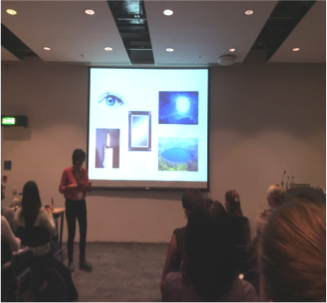 Two sample activities
Two sample activities
Telltale objects
•Think of an object you have and think you are that object.
•Think about your life as the object.
•You are now at a party. Talk to people e.g. Hello I'm a colourful tape dispenser... and form a mini dialog
•Feedback: what type of objects have you found?
This was a simple but interesting activity where we found ourselves looking at life through an object which also appeared to be revealing about the person/owner of the object.
The mirror
This was a sequence of tasks where in pairs, we were asked to compare and contrast pictures e.g. a candle, an eye, a mirror, the moon. With 1 clap of the hands, our partners talked about similarities and 2 claps meant we wanted them to talk about the differences. This was then followed by several other steps using Slyvia Plath’s poem, ‘Mirror’ with which we engaged in tasks such as one where we were invited to answer the question “What are the wall’s thoughts?” based on the highlighted section in the poem:
I am silver and exact. I have no preconceptions.
Whatever I see I swallow immediately
Just as it is, unmisted by love or dislike.
I am not cruel, only truthful,
The eye of a little god, four-cornered.
Most of the time I meditate on the opposite wall.
It is pink, with speckles. I have looked at it so long
I think it is part of my heart. But it flickers.
Faces and darkness separate us over and over.
Now I am a lake. A woman bends over me,
Searching my reaches for what she really is.
Then she turns to those liars, the candles or the moon.
I see her back, and reflect it faithfully.
She rewards me with tears and an agitation of hands.
I am important to her. She comes and goes.
Each morning it is her face that replaces the darkness.
In me she has drowned a young girl, and in me an old woman
Rises toward her day after day, like a terrible fish.
Judit Feher is a member of the Creativity Group. You can visit their website and if interested, become a member at: www.thecreativitygroup.weebly.com
Training Outside the Box: Teacher-centered Alternatives to Traditional INSETT Rose Aylett, British Council Egypt
In this highly effective presentation Rose Aylett shared three alternative formats to transform training sessions into collaborative, personalised learning experiences based on teacher- generated issues. Aylett first discussed that trainer fatigue was something similar to what professional athletes suffer from due to intensity of training, compulsory work, timing, routine, and pressure. She then emphasized the importance of how a new paradigm can surprise, inspire and promote learner autonomy among participants.
Aylett presented the following three ideas for transforming training sessions into collaborative, personalised learning experiences through teacher-led projects:
•Art exhibition for lesson plans: Teachers and trainers shared lesson plans in the set up of an ‘art exhibition’. Teachers were initially not interested but they became more interested after trainers talked to them individually e.g. asking teachers what they do and why they do it. Other possible ideas for a gallery might be ones where teachers share: materials, games, students' work, quotes/photos (or a sequence of photos), and even board work.
•Learner autonomy day for teachers: Trade Fairs is another INSETT format. Teachers in teams shared ideas ‘selling’ them using paper money. Teachers liked this very much and found it collaborative.
 •Classroom clinics: An Informal drop in for teachers to discuss issues in class with a few other teachers based on rules such as, doctor-patient confidentiality, hippocratic oath, visiting again for weekly check up :
•Classroom clinics: An Informal drop in for teachers to discuss issues in class with a few other teachers based on rules such as, doctor-patient confidentiality, hippocratic oath, visiting again for weekly check up :
oFirst examination where a teacher talks about her issue
oDiagnosis: their colleagues listen and then share their diagnosis
oPrescription where suggestions and remedies are discussed.
You may wish to visit Rose Aylett’s Padlet page at: https://padlet.com/Egypt/artofplanning
Connecting Minds: Language Learner and Teacher Psychologies Sarah Mercer, University of Graz
In her plenary, Sarah Mercer focused on the fundamental role played by psychology in the learning and teaching of foreign languages, emphasizing how crucial an understanding of psychology is, given that people and their relationships lie at the heart of the teaching/learning interaction. Mercer shared her belief that teachers would never become obsolete and that psychologically teachers can make a huge difference to the lives of their learners (Duckworth 2006) every single day; teachers develop positive relationships, focus on positivity and growth, and also nurture their own professional well-being.
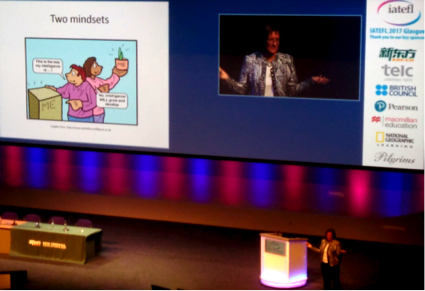 Mercer discussed the role of teachers in Hattie’s research (2009) where Hattie presents a ranking of 138 effects related to student achievement and shared that ‘Teacher student relationships’ were surprisingly ranked as number 11 (https://visible-learning.org/2016/04/hattie-ranking-backup-of-138-effects/) when social relationships and the connection between students and teachers are in fact so central to learning. She also stated that psychology was not just about motivation, cognition or an abstracted, internal mind and that it related to beliefs, emotions, sense of self, agency and engagement and emphasized the role of teachers using various examples e.g. burnout cascade (Holmes, 2012) and the virtuous cycle (Rogers, 2012). Mercer added that open communication, trust, warmth, being empathetic, and reciprocity were among the top qualities people look for in their relationship.
Mercer discussed the role of teachers in Hattie’s research (2009) where Hattie presents a ranking of 138 effects related to student achievement and shared that ‘Teacher student relationships’ were surprisingly ranked as number 11 (https://visible-learning.org/2016/04/hattie-ranking-backup-of-138-effects/) when social relationships and the connection between students and teachers are in fact so central to learning. She also stated that psychology was not just about motivation, cognition or an abstracted, internal mind and that it related to beliefs, emotions, sense of self, agency and engagement and emphasized the role of teachers using various examples e.g. burnout cascade (Holmes, 2012) and the virtuous cycle (Rogers, 2012). Mercer added that open communication, trust, warmth, being empathetic, and reciprocity were among the top qualities people look for in their relationship.
Mercer argued that we need to start looking at teachers and that schools should support teachers in areas such as stress management, self-compassion, regular exercise, etc. Mercer used an analogy from flight announcements where in case of a loss of cabin pressure and oxygen masks deploy, people are expected to attend to themselves first before attending their child:
“While teaching materials and specific methodologies remain vitally important, it is impossible to reap the full benefits offered by such resources without those involved being psychologically in a facilitative frame of mind.”
Teaching and Research: What has Neuroscience Ever Done for Us? Carol Lethaby (The New School/ US Berkeley Extension) and Patricia Harries (Freelance)
In this highly popular presentation, using teaching examples, Carol Lethaby and Patricia Harries argued that research can help teachers to recognize and avoid classroom practices based on misconceptions about brain-based learning; and to apply recent findings about the brain in order to enhance and validate best practice. They focused on uncovering neuromyths and incorrect assertions about how the brain is involved in learning.
Lethaby and Harries referred to both neuroscience studies and their own research using a teacher survey on teacher beliefs (n= 332) where participants from the US, Canada, Mexico and Brazil were given 9 statements and asked if they agreed or disagreed with them. The two statements they then discussed with the audience were related to VAK and right-left hemisphere orientation/learning. The fact that a great majority of the teachers in the survey agreed with the two statements showed that teachers believe in neuromyths. They then expanded on these neuromyths with ‘evidence’ e.g. using MRI we can see how VAK are connected in information processing and are not separate; there is no evidence that teaching to learning styles improves learning; and neuroscience shows both left and right hemispheres are used for processing logical and creative tasks.
The presenters then discussed that neuroscience has helped us to focus on evidence-based learning - ideas that do have a research base:
1.the effect of prior knowledge; prior knowledge affects what we perceive (and in reading and comprehension)
2.knowing about learners' interests
3.cognitive load: text and visuals need to support each other otherwise it could lead to cognitive overload
They also referred to a study by Van Kesteren et al. (2014) focusing on how our brain remembers new study-related information. This was an MRI study which showed that students best remembered information related to their own fields of study and linked to prior information in their own field of study. This was associated with the medial frontal cortex; how actively students used this area of the brain was predictive of their future academic success.
Lethaby and Harries then shared several recommendations on what to do based on this research:
•Using pre-tasks to activate and build prior knowledge (content, L1 and L2)
•Recycling and spiral curriculum
•Reconsidering the content of learning styles on syllabuses and in assessment criteria e.g. UCLES CELTA and DELTA
•Not using VAK or left-right brain questionnaires/tests etc.
Increasing Individual Stretch and Challenge - A Practical Solution Matthew Calvert and Helen Ford, South Thames College, London
In this session the presenters shared a project they had initiated in order to support CPD ownership in their college context where CPD is compulsory for teachers. Their additional challenge was to ensure that Ofsted (Office for Standards in Education, Children's Services and Skills, UK) criteria on differentiation in learning was met and needed to show evidence from their classes and practices.
Calvert and Ford developed an adaptable and recyclable approach encouraging learner autonomy, personalised learning and individual stretch and challenge, with minimal teacher intervention. The CPD project consisted of the following components:
・Team approach to solving the problem
・Literature review (post it and pass the article on; an hour of silent reading of articles and post-itting with notes)
・Ongoing review and improvement
・Evaluation
In their project, Calvert and Ford focused specifically on dealing with students who finish tasks early or need an additional challenge while working on a task. They came up with the following principles:
•Not more of the same tasks e.g. no death by worksheet
•Tasks need to do more than just keeping the students busy
•Tasks need to be easy for students to understand and carry out
•Students need to take ownership of the task
•The task needs to be quick to check through peer or self-assessment
Following their preparation, planning and principles, they then prepared ‘Add on’ and ‘Add in’ cards. These cards were aimed at early finishing students; giving them either pre-planned task cards (‘add in’) or task cards at the end of a task if they have finished early (‘add on’). The task targets were related to individual learning plans e.g. vocabulary 'stretch' tasks (Please see screenshot for sample).
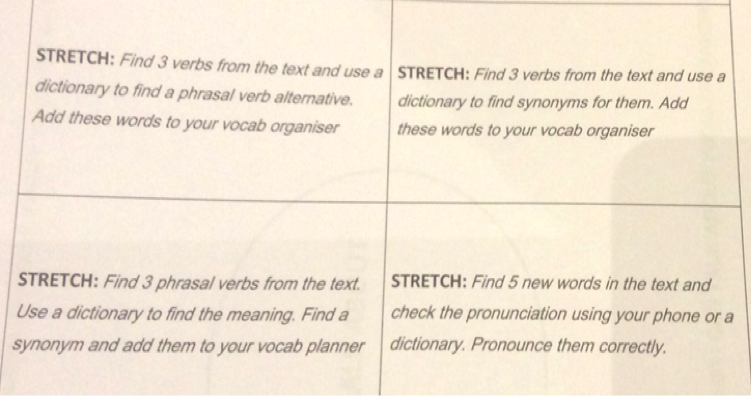
The approach helped teachers support differentiation in learning and helped students develop greater autonomy. Other advantages of the cards were that they were reusable, transferable and ready to use. Upon reflection on the session, it would also be useful to consider tasks such as: content/mini-research-based tasks; experience-based tasks and student-generated task cards.
ELT and Social Justice: opportunities in a Time of Chaos JJ Wilson, Western New Mexico University
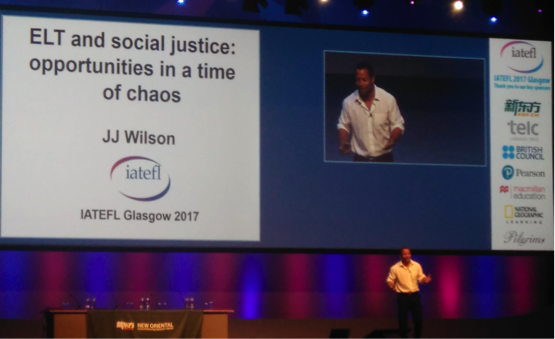
“The job of a citizen is to keep his mouth open.” (Günther Grass) Teaching is never neutral. Through our methods, classroom persona, and the materials we use, teachers advocate certain values. These values depend on one’s beliefs – one’s conception of education and the teacher’s role. Some believe that all teachers should use their creativity and passion to bring about social change. They regard their role as pivotal in the development of students-as-critical thinkers who are able to challenge the status quo. Others see themselves as providers of language only. The question for us is: “Should language teachers only teach language?” Or should we include a covert curriculum that gets our students to think critically and speak up about injustice in the world?
In his highly influential plenary, JJ Wilson talked about building relationships with students and empathizing with them as well as rethinking our identity as teachers and educators. He also introduced the idea of social justice and how it can inform our lessons and our approach to teaching. ‘Should language teachers only teach language?’ was the question he posed; he referenced major theorists like John Dewey and Paulo Freire, especially the latter’s ‘Pedagogy of the Oppressed’, which helped Wilson reshape his teaching. He proposed using images, poetry, drama, stories and community projects as means of including social justice issues in ELT classrooms.
Wilson then made mention of Agusto Boal’s Forum Theatre, a technique through which students can transform their ideas and experiences into words and work on beliefs and preconceptions. Wilson also suggested that teachers should not treat global justice issues as separate from all other lessons but that they incorporate some of them every time they step into the classroom as a ‘way of being’ and not a recipe for becoming a better teacher.
A final point he made is that the role of the teacher is not to impose their worldview on the students, but rather to expose students to issues and pose the right questions for them to draw their own conclusions.
Forum on Listening Marie Willoughby (International House, London) and Clive Shaw (Brunel University)
In this Forum, Marie Willoughby talked about setting up extensive reading projects with learners across a series of lessons using the same text; she demonstrated how she used a podcast to engage learners to follow a story and retell it by dividing it in mini episodes and focusing on one aspect of meaning at a time.
This presentation was followed by Clive Shaw, who talked about an experiment he conducted with students taking control of the listening process. He focused on individualizing listening lessons and shared his results with us.
Integrating Paraphrasing with Note Taking: An Approach for EAP Teachers Barbara Howarth, Glasgow International College, UK
In this session Barbara Howarth proposed a structured technique for helping upper-intermediate students paraphrase from an authentic journal article. Some issues regarding paraphrasing in her context included lack of or misunderstanding parts of a text, applying a sentence by sentence approach and hence missing out important supporting information and producing work that is too close to the original text. In order to deal with these issues, Howarth suggested a holistic approach to paraphrasing that integrates reading and note-taking. She stressed that such an approach facilitates students’ understanding of the information, helps students discern supporting information to contextualize the information to be paraphrased and results in original student work.
The first step in this technique is deciding which point from the original text will form the quintessential point of the paraphrase i.e. the “central point”. The next step is identifying relevant information in the text by highlighting and annotating. In order to help students at this stage, Howarth made use of a handout which included the same outline as the piece of writing the students are required to produce. Using the handout, students are asked to select parts of a text, note down the page and paragraph numbers for specific sections of a piece of writing. The third stage is about comprehension. At this stage, students are guided to check their understanding of the central elements of information from the original text. Here questions such as ‘What/Who/Which measures/How etc.’ could be helpful for comprehension. In order to avoid plagiarism Barbara advised that answers to such questions should not be more than a few words for each part. While students are writing a few words under each heading, they are also asked to underline words, phrases that are essential for the study that they are working on. Step four focuses on identifying useable vocabulary in the text. Inevitably some words and phrases should stay the same while paraphrasing. Students are asked to identify those words and phrases and discuss why they should not be changed. In order to start thinking about the paraphrase, students are also advised to check for any synonyms or synonymous expressions in the text. Then, the teacher and the students start working on generating the language necessary for the rhetorical pattern for that specific piece of writing. At this stage, grammar and vocabulary are both explored. Some examples could include working on tenses and reporting verbs. In the final stage, students draft a paraphrase, assimilate meaning, review and refine and then write a final paraphrase.
In conclusion, Barbara stressed that paraphrasing is more than a one-to-one sentence transformation exercise and that paraphrasing, note-taking and summarizing are integrated skills. In addition, for paraphrases to be successful, students need to select contextual information from the original text and work on both grammar and vocabulary before even starting to write anything. It should also be noted that paraphrasing requires editing and review before it could be regarded as final.
From Can’t to Can: Changing Our Thinking about Exams David Petrie, International House Santa Clara
David Petrie stated that learners often think of the exams in terms of what they can’t do and encouraged us to look at changing the focus of exam teaching from ability lacks to ability strengths, and to explore how to work with learners throughout a course to change feelings of anxiety, fear and stress into feelings of pride, achievement and confidence.
Petrie used a ‘word diamond’ activity which teachers can use in class to find out what their students’ feelings are towards exams in general. This also allows students to see how they see themselves and whether they think of themselves as ‘good’ or ‘bad’ learners and their perception of a ‘good’ or a ‘bad’ student. Petrie showed some samples of this ‘word diamond’ done in some of his classes and came to the conclusion that generally students relate success with numbers and grades and if they fail to get the necessary grades, they somehow see themselves failing to achieve being a good student.
Petrie drew our attention to the characteristics of confidence and anxiety and how these affect students. In order to support students to move from anxiety to confidence zone, Petrie suggested three areas to focus on:
•self-knowledge,
•subject-knowledge
•task knowledge
Subject knowledge is related to the provision of years’ and years’ of language tuition learners have been through – knowledge of systems and skills and knowledge of helping students to achieve self-knowledge. It is also trying to help students analyze what they can do and what they actually do. According to Petrie, self-knowledge is a bit more difficult to come by. Petrie used Johari Window’s technique, which is used to help people better understand their relationship with themselves and others, and asked the participants to relate this technique to the ELT context. The third focus area was on task knowledge; in the exam context and in trying to reduce exam anxiety, teachers are trying to relate learners’ self awareness to their exam achievements. To this end ‘can do statements’ are an essential tool to make students aware of what they can achieve.
An Exploration of Teacher Scaffolding Talk in the EAP Classroom Marion Heron (University of Surrey) and Jo Webster(Sheffield Hallam University)
In this presentation Marion Heron and Jo Webster shared their research and findings on scaffolding talk and what it is that makes a lesson an EAP lesson. Their research question was: How do experienced teachers use classroom talk to support the pedagogic goals of EAP? aiming to explore an ‘under-examined genre’ (Lee, 2016). The research informants were pre-sessional EAP and in-sessional ESP students as well as qualified tutors. Heron and Webster used data from observations and video recordings of 6 EAP lessons, transcribed excerpts verbatim and chose 'critical moments' (Myhill & Warren, 2005) for their analysis.
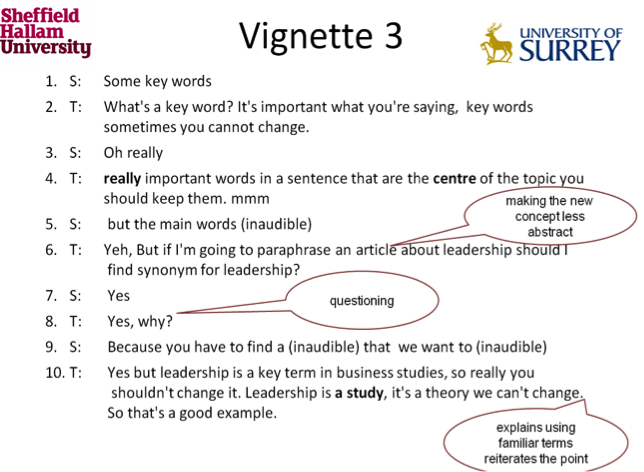
The analysis was carried out using Van de Pol et al.’s framework for scaffolding in teacher student interaction (2010) and focused on both metacognitive and affective scaffolding:
¥Support of metacognitive activities e.g. direction maintenance: the teacher keeps the students focused on future goals (“Today, we're going to look at paraphrasing and summary”.)
¥Support of student affect e.g. the teacher engages and interests the student in the activities
(“Can Charlie can you give me an example of a developing country?”) or the teacher maintains motivation through praise (“OK really good generally there it's a really good start all you have to do after that is just check the grammar is correct”.)
¥Support of cognitive activities e.g. the teacher encourages noticing of correct forms, making comparisons between current knowledge and expected level (“Who is the writer of this book and when was it written?”) or the teacher simplifies the task for the student (“What, could you think of a word to describe them, adjective so some people believe one thing, some people believe the other thing”.)
After sharing several vignettes and analysis samples with the audience, Heron and Webster summarized the implications of their work: the need to support (new) EAP teachers; explicit links between classroom activities to future contexts and academic requirements; importance of student affect; power of transcriptions – training and professional development.
Global Issues Special Interest Group (GISIG) Open Forum
In this highly effective forum, speakers from the GISIG such as Elena Yastrebova (Bringing the humane perspective in the university ELT classroom), Judy Boyle (The No Slavery Project), and Katy Muench (Tackling -isms and -phobias in the Turkish classroom) emphasized the need for contemporary issues to be introduced in the ELT class. They talked about the need for students to be exposed to real-life topics rather than just study the mechanics of the language. There was a lot of useful discussion on how these issues can be brought into the class in a non-threatening manner and on how the role of the teacher is to facilitate the exchange of opinions without imposing his/her own.
